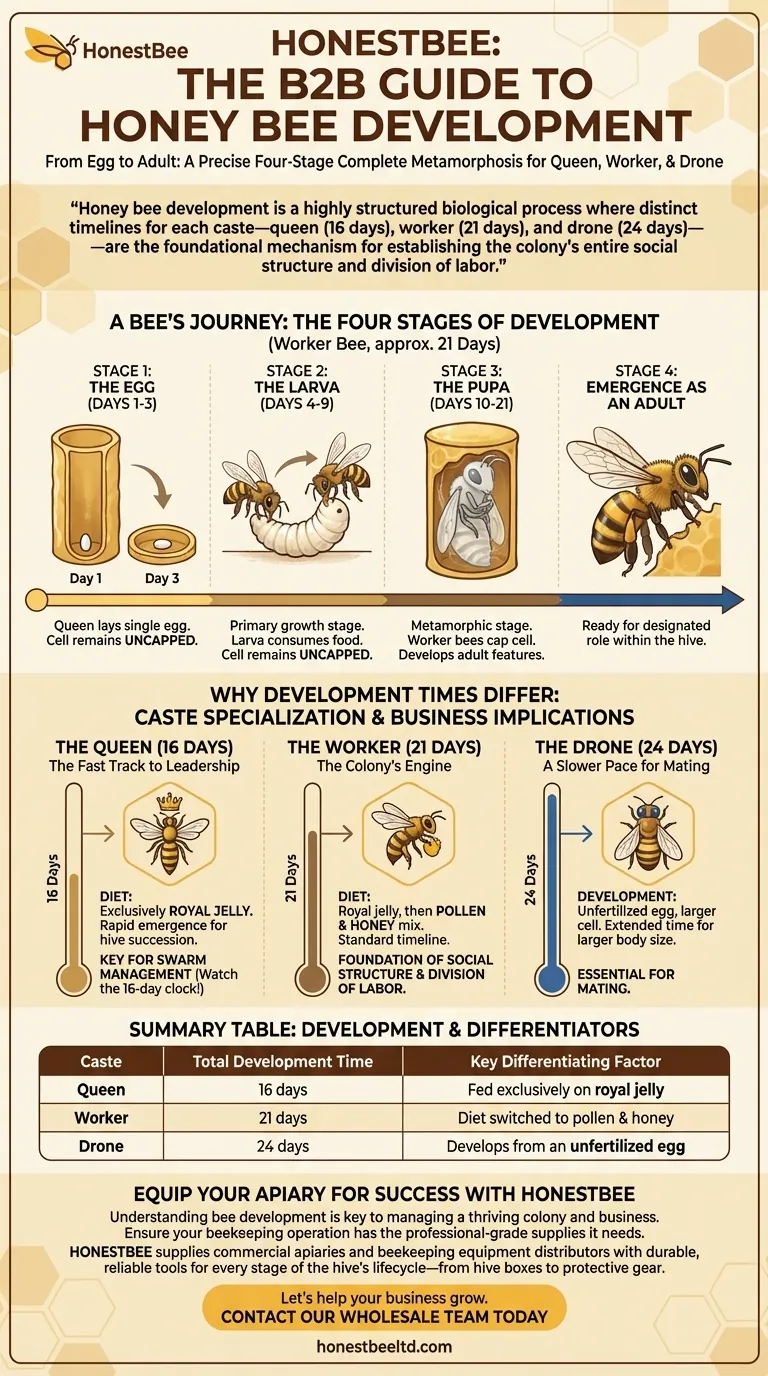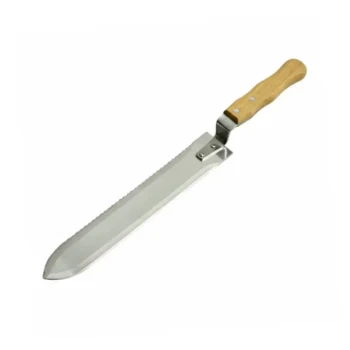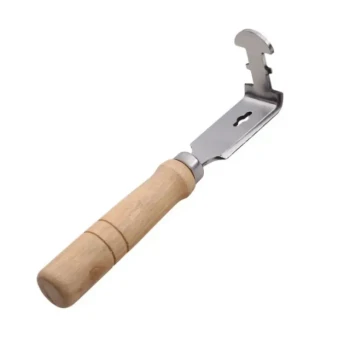The transformation from a single egg to an adult honey bee is a precise, four-stage process known as complete metamorphosis. A honey bee develops through the egg, larva, pupa, and adult stages, with the entire timeline varying significantly depending on whether the bee will become a queen, a worker, or a drone.
Honey bee development is a highly structured biological process where distinct timelines for each caste—queen (16 days), worker (21 days), and drone (24 days)—are the foundational mechanism for establishing the colony's entire social structure and division of labor.

A Bee's Journey: The Four Stages of Development
The journey from egg to adult bee is a predictable sequence. For a worker bee, this process takes approximately 21 days, a timeline that serves as a useful benchmark for understanding all three castes.
Stage 1: The Egg (Days 1-3)
The queen bee lays a single, tiny white egg into a wax cell. For the first day, the egg stands vertically. By the third day, it lies flat on the bottom of the cell, ready to hatch.
During this entire period, the cell remains uncapped.
Stage 2: The Larva (Days 4-9)
The egg hatches into a small, white, legless grub called a larva. This is the primary growth stage, where the larva consumes food provided by worker bees and increases its size dramatically.
The cell remains uncapped throughout the larval stage to allow for continuous feeding by nurse bees.
Stage 3: The Pupa (Days 10-21)
Once the larva is fully grown, worker bees cap its cell with a layer of beeswax. Inside this sealed cell, the larva spins a cocoon and begins its transformation into a pupa.
This is the metamorphic stage where the pupa, which initially looks like a pale, ghost-like bee, develops its adult features: eyes, legs, wings, and internal organs.
Stage 4: Emergence as an Adult
After the pupal stage is complete, the fully formed young adult bee chews its way through the wax capping. It emerges ready to take on its designated role within the hive.
Why Development Times Differ: Caste Specialization
The most critical factor influencing development time is the bee's caste. This specialization is determined early in the larval stage and is essential for the colony's function.
The Queen (16 Days): The Fast Track to Leadership
A queen develops faster than any other bee. This is because her larval diet consists exclusively of royal jelly, a nutrient-rich secretion that accelerates her growth and sexual development. A rapid emergence is critical for hive succession.
The Worker (21 Days): The Colony's Engine
Female worker bees represent the standard developmental timeline. While they receive royal jelly for the first few days, their diet is then switched to a mixture of pollen and honey, slowing their development compared to a queen.
The Drone (24 Days): A Slower Pace for Mating
Male bees, or drones, take the longest to develop. They develop from unfertilized eggs in slightly larger cells. Their extended development time accommodates their larger body size, which is necessary for their sole function of mating with a new queen.
Making the Right Choice for Your Goal
Understanding these developmental timelines is not just academic; it is a practical tool for anyone who works with or studies honey bees.
- If your primary focus is hive health assessment: Knowing these timelines allows you to look at the brood pattern and confirm you have a healthy, laying queen by seeing eggs, young larvae, and capped pupae in a consistent sequence.
- If your primary focus is swarm management: The 16-day queen development cycle is the most important clock to watch, as the emergence of a new queen often precedes the departure of a swarm.
- If your primary focus is understanding colony biology: The distinct developmental paths for each caste are the foundation of the social structure and division of labor that make honey bee colonies so successful.
By understanding this developmental blueprint, you move from simply observing bees to truly interpreting the health, status, and future of the entire colony.
Summary Table:
| Caste | Total Development Time | Key Differentiating Factor |
|---|---|---|
| Queen | 16 days | Fed exclusively on royal jelly |
| Worker | 21 days | Diet switched to pollen & honey after a few days |
| Drone | 24 days | Develops from an unfertilized egg in a larger cell |
Equip Your Apiary for Success with HONESTBEE
Understanding bee development is key to managing a thriving colony. Ensure your beekeeping operation has the professional-grade supplies it needs. HONESTBEE supplies commercial apiaries and beekeeping equipment distributors with the durable, reliable tools required for every stage of the hive's lifecycle—from hive boxes and frames for brood rearing to protective gear and harvesting equipment.
Let's help your business grow. Contact our wholesale team today to discuss your specific needs and volume pricing.
Visual Guide

Related Products
- Professional Extra-Wide Uncapping Fork with Bent Tines for Beekeeping
- Professional 3-Bar Frame Grip with Integrated Hive Tool
- HONESTBEE Advanced Ergonomic Stainless Steel Hive Tool for Beekeeping
- Professional Dual-End Stainless Steel Hive Tool for Beekeeping
- Beehive Handle and Frame Rest Cutting Machine: Your Specialized Hive Machine
People Also Ask
- How does comb depth affect the efficiency of uncapping tools? Match Your Tool for a Faster Harvest
- What are the key tools needed for extracting honey? A Guide for Apiaries & Distributors
- What is the overall recommendation for beginner beekeepers regarding uncapping tools? Master Your First Honey Harvest
- What other tools are available for honey uncapping besides knives? Find the Right Tool for Your Apiary's Scale
- How long does it take to extract honey from frames? Plan Your Harvest Efficiently



















